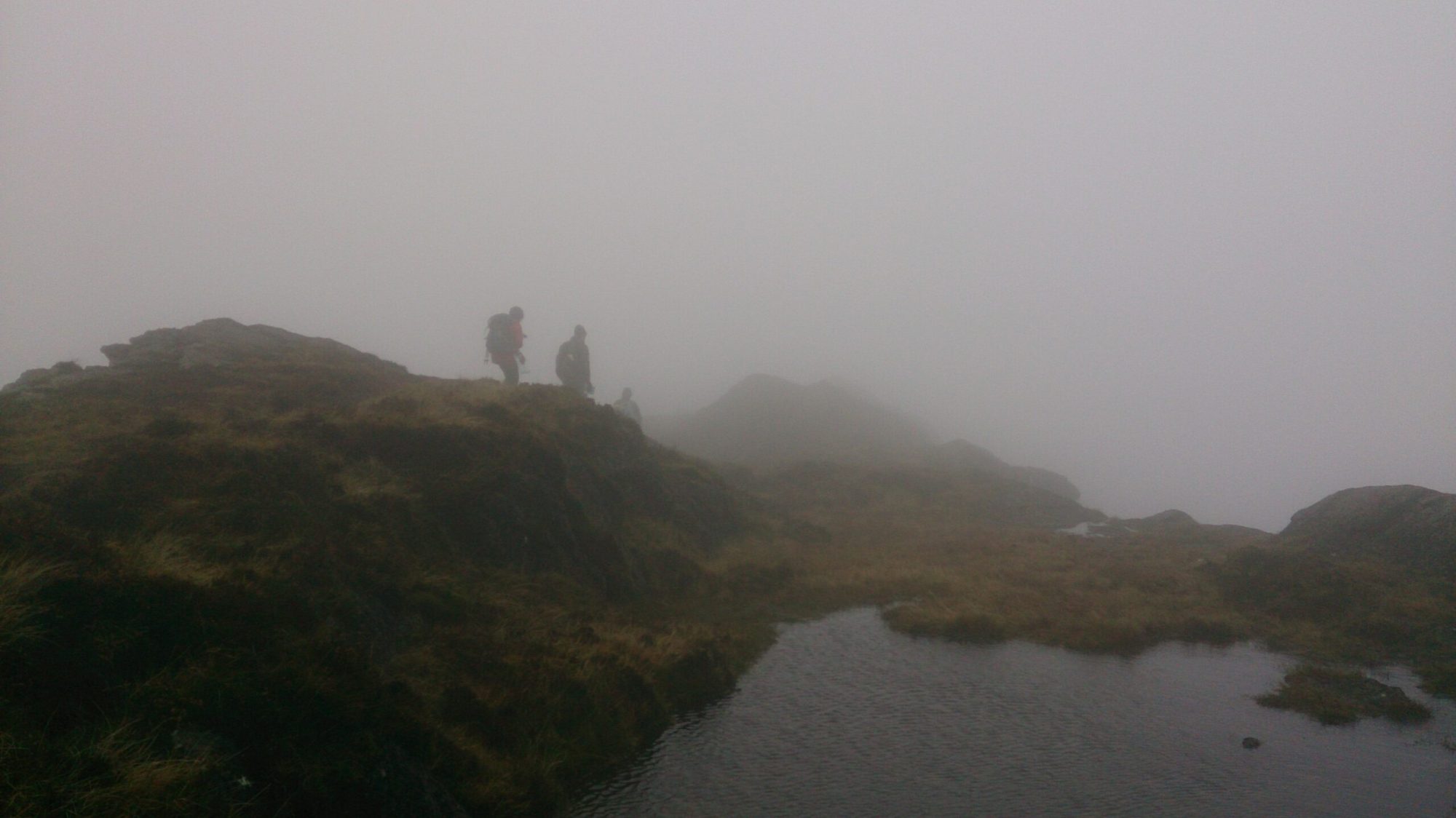20 Top Tips for trouble free navigation

Accurate mountain navigation in misty conditions is one of the most important skills you can learn as a hillwalker. Mountain Rescue teams are regularly called out to hikers who have become disorientated by poor visibility in the mountains. Always carry a map and compass, and have the skills to use them.
However, even the best navigators can make mistakes. By following the tips given below you can avoid making some of the common navigation errors and minimise the chances of becoming disorientated in the mountains.
- In poor visibility, always take a bearing from a summit to determine your direction of onward travel. You may think you know the right direction to go, but a short distraction for a photograph or a rummage in your pack and you can quickly become disorientated and head off the wrong way. Taking a bearing from the map will ensure you leave the summit in the direction you intended to.
- Always estimate your bearing first. For example, if your intended direction of travel is approximately due west, then the bearing will be in the region of 270°. If it is not then you know you have made an error, and need to check it again.
- Remember to allow for magnetic variation, this usually means a small adjustment by adding a few degrees to your bearing. The magnetic variation differs depending on your location, you can find it somewhere in the margins of your map, usually in the legend. Check it out before you leave home and remember it, or write it down on your route card.
- Write down any important bearings that might be needed during the day. This will avoid fiddly compass work in a possibly wet and windy location, and will reduce the chance of errors. You can write them into your route card. This is your overall route for the day, broken down into a series of ‘navigation legs’, with the essential information such as distance, bearings, height gain and escape routes, written down in the form of a chart.Route card for Moel Siabod in Snowdonia.
- Make sure you keep your compass away from magnetic and metallic objects at all times, and especially when taking and walking on a bearing. They will deflect the needle in the compass and lead to navigational errors you won’t be able to correct later. Long term exposure of your compass to a magnetic source, such as your mobile phone, can result in permanent damage and reversed polarity of the needle, so store your compass in a location well away from your phone and other electronic devices.
- When placing the compass on the map to take a bearing, remember to face the direction of travel arrow on the base plate AWAY from your current position and TOWARDS your target. This will avoid the classic error of the bearing being 180° out.
- Accuracy is everything when taking a bearing, a small error in your measurement can lead to you missing your target completely in poor visibility. This is especially true over longer distance ‘legs’ as the error margin increases the further you travel.
- For a very challenging section of navigation get another member of your group to navigate it as well. Then you can check your measurements, bearings and direction with each other to help avoid errors.
- Keep your map and compass flat (horizontal) when taking your bearing. Better still, go down on one knee for a more stable position with some protection from the wind and rain, rest your map on the none kneeling leg.Accuracy is paramount when taking a bearing, even a small error can lead you a long way off route.
- To ensure you are not wandering off your bearing it can be useful, while your start point is still in view, to take a back bearing. Turn to face your start point and line up the white end of the needle with the orienting arrow, rather than the red The direction of travel arrow should now be pointing at the start point. If it is not move sideways until it does, you are now on the right bearing and can turn back to face your travel direction.
- Remember to measure the distance from your start point to the target. You can now pace this distance, or time it with your watch, to know when you should be at the target point.
- It’s a good idea to keep a timing card in your pocket or somewhere handy. This has written on it the time it takes to walk over a range of distances at a variety of walking speeds. It will speed up your calculations and help eliminate errors when you might be cold and tired on the mountain.A timing card will make distance calculations easier and avoid errors.
- Make sure the orientation arrow of the compass is pointing north when you are taking a bearing, have the top of the map, which always points to grid north, facing away from you. If you inadvertently line up the orienting arrow pointing south, the bearing will again be 180° out, an estimation of the bearing as above will soon pick this up.
- If you struggle to manipulate the compass housing when wearing bulky gloves, try wearing lightweight liner gloves underneath. You can then remove the outer gloves and use your compass while still giving your hands some protection from the weather.
- Never carry the whole map, cut or photocopy the part of the map you are hiking on and put this cut down section in a waterproof map case. This will make your map reading much easier and slicker in windy and wet conditions.
- Remember to orientate or ‘set’ the map before each navigation leg. Identifing features on the ground and lining them up with the same features on the map will often clarify a confusing situation and give you a direction of travel.
- Identify landmarks along a ‘leg’ of the route from the map and tick these off as you come across them. These ‘tick features’ will give you confidence and reassurance that your navigation is going to plan.
- You should try to have up to three features of your target location that you can identify to help you confirm you are in the right place. A further feature, called a ‘catching feature’ should be identified from the map, and will tell you when you have overshot the target.
- If things don’t look right then they probably arn’t. Always ask yourself, ‘Do I see what I expect to see?’. If the answer is no then stop and reassess the situation. Don’t go blindly on increasing your error and making relocation harder.
- If you are entirely unsure about your position, you can line up the white end of the needle with the orienting arrow. The direction of travel arrow on the compass housing will now point back the way you have just come. You can follow this back to your starting point, (your last known position), and begin the process over again.
If you want know more about poor visibility navigation, you can join one of our navigation courses for novices and improvers. Held at weekends throughout the year you can find out more on our website at: Mountaintrails Navigation Courses.

